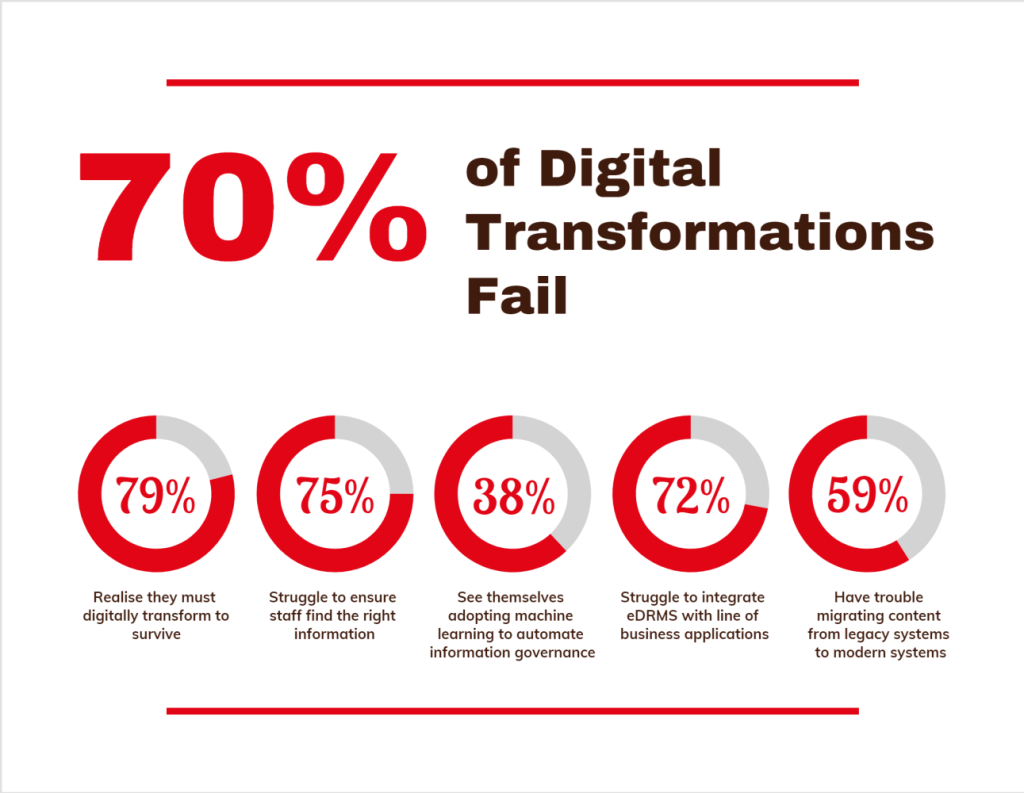
The Dark Side of Digital Transformation: 5 Pitfalls to Watch Out For

Digital transformation can be a daunting task for many organizations, as it requires a significant amount of effort, resources, and coordination across multiple departments.
Many companies have attempted digital transformation in the past and failed due to a variety of reasons. In this article, we’ll discuss some common pitfalls to avoid during digital transformation and provide actionable advice on how to overcome them.
Common Pitfalls to Avoid During Digital Transformation
1. Lack of Clear Strategy and Vision
One of the most common pitfalls during digital transformation is the lack of a clear strategy and vision. A clear strategy and vision help to align stakeholders and ensure that everyone is working towards the same goals. Without a clear vision, digital transformation can become a disjointed and frustrating process.
2. Resistance to Change
Resistance to change can come from many sources, including employees, stakeholders, and management. Employees may be resistant to change because they are comfortable with their current processes, while management may be hesitant to invest in new technology. Overcoming resistance to change requires effective communication and a willingness to address concerns and fears.
3. Siloed Thinking and Lack of Collaboration
Digital transformation often requires cross-functional collaboration, and a siloed approach can hinder progress. When departments work independently, it can lead to duplicated efforts and missed opportunities. To avoid siloed thinking, it is important to create cross-functional teams and encourage collaboration across departments and functions.
4. Inadequate Data Management
Digital transformation relies on accurate and timely data, and inadequate data management can result in poor decision-making and inefficiencies. To avoid inadequate data management, it is important to prioritize data management and analytics. Ensure that data is accurate, timely, and easily accessible.
5. Poor Communication and Stakeholder Management
Lack of communication and stakeholder management can lead to misunderstandings, delays, and missed opportunities. To overcome this pitfall, it is important to communicate frequently and transparently with stakeholders, actively manage stakeholder expectations, and ensure that everyone is informed and up to date on the project’s progress.
Real-Life Examples of Digital Disaster:
- A manufacturing company implemented a new Enterprise Resource Planning (ERP) system to manage its inventory, production, and financials. However, the system was not properly integrated with their existing Customer Relationship Management (CRM) system, resulting in duplicated customer records and incorrect inventory levels. This led to decreased productivity, increased costs, and customer dissatisfaction.
- A financial services company implemented a new online banking platform without conducting sufficient testing. As a result, the platform experienced frequent downtime and errors, causing frustration for customers and decreased productivity for employees. The company had to invest additional resources to fix the issues and ensure that the platform met their requirements.
- A manufacturing company implemented a new Enterprise Resource Planning (ERP) system to manage its inventory, production, and financials. However, the system was not properly integrated with their existing Customer Relationship Management (CRM) system, resulting in duplicated customer records and incorrect inventory levels. This led to decreased productivity, increased costs, and customer dissatisfaction.
- A healthcare organization implemented a new electronic medical records (EMR) system to manage patient data. However, as the organization grew, the system was unable to handle the increased demand, resulting in slow response times and decreased productivity. The organization had to invest in additional resources to maintain the system, which increased their costs.
- A government agency implemented a new system for processing permits and licenses, but employees were resistant to the change. Many employees continued to use the old system, resulting in duplication of effort and decreased productivity. The agency had to invest in additional resources to provide training and support to employees to promote the adoption of the new system.
How to Avoid Pitfalls and Embrace Success

Establish Clear Goals and a Compelling Vision
To overcome the lack of clear strategy and vision, establish clear goals and a compelling vision for your digital transformation project. Communicate this vision widely and ensure that everyone understands the end goal.
Foster a Culture of Innovation and Continuous Improvement
To overcome resistance to change, foster a culture of innovation and continuous improvement. Encourage experimentation and learning, and celebrate successes along the way. This can help to create a sense of excitement and anticipation for the changes that are to come.
Break Down Silos and Encourage Collaboration
To avoid siloed thinking, create cross-functional teams and encourage collaboration across departments and functions. This can help to ensure that everyone is working towards the same goals and can lead to a more efficient and effective digital transformation process.
Prioritize Data Management and Analytics
To avoid inadequate data management, prioritize data management and analytics. Ensure that data is accurate, timely, and easily accessible. This can help to ensure that you are making informed decisions throughout the digital transformation process. ServiceNow provides a single system of record for all digital transformation data, including incident reports, change requests, and service requests. This makes it easier to manage and access data and ensures that data is accurate and up-to-date. It provides powerful analytics capabilities that allow you to gain insights from your data. These insights can be used to identify trends, detect patterns, and make informed decisions about digital transformation initiatives.
Communicate Frequently and Transparently
To avoid poor communication and stakeholder management, communicate frequently and transparently with stakeholders. Actively manage stakeholder expectations and ensure that everyone is informed and up to date on the project’s progress. This can help to ensure that everyone is on the same page and can lead to a more successful digital transformation project.
In Summary

Digital transformation is no longer an optional strategy but a necessity for businesses to thrive in today’s digital age. While there are common pitfalls that can hinder the success of digital transformation, there are also best practices that can help organizations overcome them. By following these best practices, organizations can transform their operations, create new opportunities, and stay competitive.
So, as you embark on your digital transformation journey, keep in mind the importance of establishing a clear strategy and vision, fostering a culture of innovation and collaboration, prioritizing data management and analytics, and communicating frequently and transparently with stakeholders.
Want to learn more?
Ready to discover how we can save you from falling into one of these traps and learn how we can support your digital transformation efforts? Contact us HERE!



